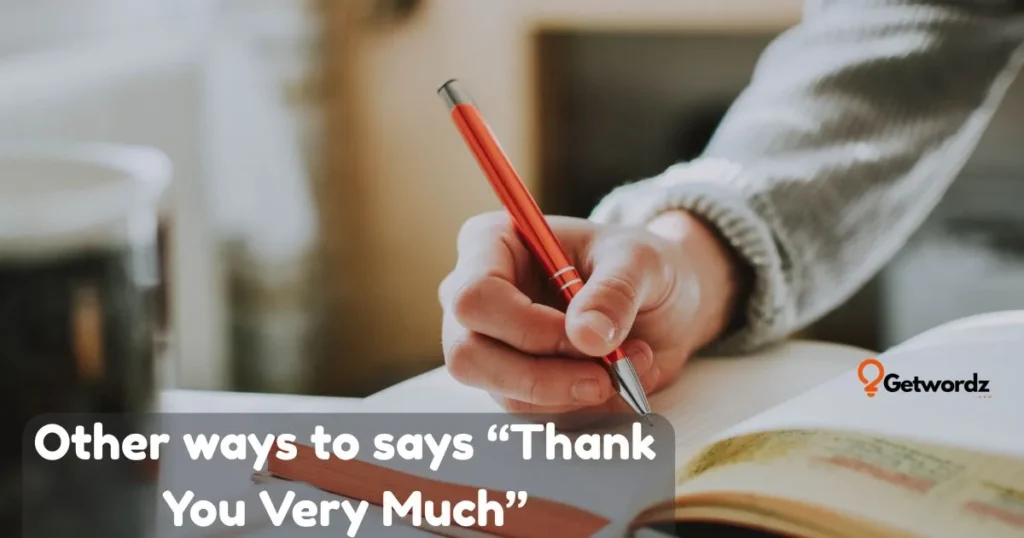Thank You Very Much is more than just a polite phrase, it’s a way to express genuine gratitude, whether to a friend who lent a helping hand, a colleague who covered your workload, or a loved one who went the extra mile. Yet, as common as it is, many of us feel that simply saying “thank you very much” can sometimes feel routine, bland, or overused.
That’s why people often search for different ways to say thank you very much, looking for creative alternatives, unique expressions, or even funny responses that feel more heartfelt and personal. In this post, we’ll explore a variety of fresh and meaningful options to replace the standard “thank you very much,” helping you convey appreciation in a way that resonates.
From casual phrases for friends to professional wording for colleagues, from heartfelt notes to playful replies, these suggestions cover every scenario. Drawing from real-life experiences and observations, this guide ensures your gratitude feels authentic and memorable, not just another generic phrase.
If you’ve ever wished your words of thanks could pack a little more punch, stay tuned, we’re about to share some creative alternatives that will make your appreciation stand out.
1. Thank You So Much
Scenario: Imagine your friend stayed late to help you finish a big project. You want to show heartfelt appreciation without sounding overly formal.
Explanation: “Thank you so much” is a versatile, warm, and slightly more enthusiastic alternative to “thank you very much.” It works in both casual and professional settings, making it a creative alternative that communicates genuine gratitude.
Examples:
- “Thank you so much for helping me move this weekend!”
- “I really appreciate your support, thank you so much!”
- “Thank you so much for the thoughtful gift; it means a lot.”
Why It Works: This phrase conveys sincerity and warmth while feeling natural. It’s flexible enough for texts, emails, and face-to-face conversations, making it a reliable choice for any scenario.
2. Many Thanks
Scenario: You received a quick favor from a colleague via email and want to acknowledge it politely.
Explanation: “Many thanks” is a concise, professional, and polished alternative to “thank you very much.” It’s a creative expression that works well in business correspondence or semi-formal settings, offering different wording that feels courteous and approachable.
Examples:
- “Many thanks for reviewing my report today.”
- “Many thanks for your prompt reply; I appreciate it.”
- “Many thanks for joining our team meeting this morning.”
Why It Works: It stands out for its brevity and professional tone. Using “many thanks” shows appreciation without overcomplicating the message.
3. Thanks a Ton
Scenario: Your roommate brought you coffee after a long night of studying, and you want to show excitement and gratitude.
Explanation: “Thanks a ton” is a playful and casual alternative. It conveys strong gratitude in a fun and enthusiastic way, making it a unique expression that feels genuine among friends or family.
Examples:
- “Thanks a ton for covering my shift yesterday!”
- “I owe you one, thanks a ton!”
- “Thanks a ton for picking up my groceries; you’re a lifesaver.”
Why It Works: This phrase adds personality and energy to your thanks, making your appreciation memorable and heartfelt.
4. Heartfelt Thanks
Scenario: You want to acknowledge a mentor who offered guidance during a crucial project.
Explanation: “Heartfelt thanks” emphasizes deep sincerity and emotional connection. It’s a creative alternative for expressing genuine appreciation and is especially effective in formal or meaningful contexts.
Examples:
- “Heartfelt thanks for all the advice you’ve given me.”
- “Heartfelt thanks for your unwavering support during this time.”
- “Heartfelt thanks to everyone who contributed to this initiative.”
Why It Works: The phrase communicates authenticity and thoughtfulness. It signals that your gratitude comes from the heart, not just habit.
5. Thanks a Bunch
Scenario: A coworker helped you troubleshoot a minor technical issue, and you want to keep it light and friendly.
Explanation: “Thanks a bunch” is casual, cheerful, and versatile. It’s a better way to say “thank you very much” in informal interactions while maintaining a playful, approachable tone.
Examples:
- “Thanks a bunch for fixing my laptop so quickly!”
- “Thanks a bunch for the invite; I had a great time.”
- “Thanks a bunch for the birthday surprise, it made my day.”
Why It Works: Its informal tone adds warmth and relatability, making your gratitude feel natural and conversational.
6. Deepest Thanks
Scenario: You received support from friends during a challenging personal situation and want to acknowledge them meaningfully.
Explanation: “Deepest thanks” communicates profound gratitude. It’s a unique expression suitable for serious, heartfelt moments and conveys sincerity in a refined way.
Examples:
- “Deepest thanks for standing by me through this difficult time.”
- “Deepest thanks to all who contributed to our charity event.”
- “Deepest thanks for your kindness and understanding.”
Why It Works: This phrase emphasizes depth and seriousness, showing that your appreciation is thoughtful and significant.
7. Sincere Thanks
Scenario: After receiving thoughtful advice from a colleague, you want to acknowledge it formally in an email.
Explanation: “Sincere thanks” is a polished alternative that communicates honesty and genuine appreciation. It’s an excellent option for professional settings or meaningful gestures.
Examples:
- “Sincere thanks for your guidance on this project.”
- “Sincere thanks for taking the time to review my work.”
- “Sincere thanks for your mentorship, it’s greatly appreciated.”
Why It Works: Using “sincere thanks” conveys authenticity and trustworthiness, enhancing the credibility of your gratitude.
8. Thanks a Million
Scenario: Your friend went out of their way to help you celebrate a milestone, and you want to express excitement and deep appreciation.
Explanation: “Thanks a million” is an enthusiastic and exaggerated way to show heartfelt thanks. It’s casual, fun, and memorable, making it a creative alternative to standard expressions.
Examples:
- “Thanks a million for planning such a wonderful surprise!”
- “Thanks a million for helping me move last weekend.”
- “Thanks a million for your support, I couldn’t have done it without you.”
Why It Works: Its energetic tone makes the gratitude feel larger-than-life, emphasizing the importance of the gesture.
9. Immense Thanks
Scenario: You want to thank a volunteer team after a successful community event.
Explanation: “Immense thanks” conveys large-scale gratitude and formality without sounding stiff. It’s a better wording alternative when you want to highlight the significance of someone’s help.
Examples:
- “Immense thanks to everyone who made this event a success.”
- “Immense thanks for your dedication and hard work.”
- “Immense thanks for the generosity you’ve shown.”
Why It Works: This phrase stands out for its grand and respectful tone, perfect for group acknowledgments or official communications.
10. Big Thanks
Scenario: Your sibling helped you prepare for an important presentation, and you want to acknowledge them casually but meaningfully.
Explanation: “Big thanks” is simple, friendly, and flexible. It’s a unique expression that conveys appreciation in both casual and semi-formal situations.
Examples:
- “Big thanks for helping me rehearse my speech!”
- “Big thanks to the team for pulling this off.”
- “Big thanks for the ride to the airport, it saved me a lot of stress.”
Why It Works: Its straightforward, approachable tone makes gratitude easy to express without sounding generic.
Read more: 30 Other Ways To Say “Hello” With Examples!
11. Thanks Kindly
Scenario: You received a thoughtful note from a neighbor offering help, and you want to reply politely and warmly.
Explanation: “Thanks kindly” is a polite and slightly formal alternative. It’s a creative expression that works in letters, emails, or messages, providing a unique way to convey gratitude without sounding overused.
Examples:
- “Thanks kindly for your generous help yesterday.”
- “Thanks kindly for sharing your expertise with me.”
- “Thanks kindly for thinking of me during this busy time.”
Why It Works: Its courteous tone conveys respect and warmth, making it ideal for formal or semi-formal interactions while still feeling sincere.
12. Many, Many Thanks
Scenario: A friend threw a surprise celebration for your birthday, and you want to show excitement and heartfelt gratitude.
Explanation: “Many, many thanks” is an enthusiastic variation of “many thanks.” It adds extra emphasis, making your appreciation feel vibrant and personal, suitable for casual or informal contexts.
Examples:
- “Many, many thanks for the amazing birthday party!”
- “Many, many thanks for helping me with my move.”
- “Many, many thanks for all the support you’ve given me.”
Why It Works: The repetition emphasizes sincerity and excitement, making your gratitude feel lively and memorable.
13. Huge Thanks
Scenario: Your coworker stayed late to help you meet a tight deadline, and you want to acknowledge them casually but genuinely.
Explanation: “Huge thanks” is a casual, friendly alternative that conveys strong appreciation. It’s a creative expression that works in emails, chats, or spoken conversation.
Examples:
- “Huge thanks for helping me finish the project on time!”
- “Huge thanks to everyone who contributed to the presentation.”
- “Huge thanks for picking up the slack when I was away.”
Why It Works: Its informal, energetic tone adds personality to your gratitude, making it feel genuine and relatable.
14. Profound Thanks
Scenario: After receiving life-changing advice from a mentor, you want to acknowledge their impact with depth and sincerity.
Explanation: “Profound thanks” communicates deep and meaningful gratitude. It’s a unique expression that works best in heartfelt, formal, or reflective situations.
Examples:
- “Profound thanks for guiding me through this career decision.”
- “Profound thanks for your invaluable advice and encouragement.”
- “Profound thanks to my mentors for their constant support.”
Why It Works: It highlights the emotional weight of your appreciation, making your gratitude feel significant and thoughtful.
15. Many Appreciations
Scenario: You want to thank a volunteer group for their hard work and dedication during a community event.
Explanation: “Many appreciations” is a professional and slightly formal alternative to “thank you very much.” It conveys recognition and respect while being a fresh way to express gratitude.
Examples:
- “Many thanks to everyone who helped organize the charity event.”
- “Many thanks for your dedication and hard work.”
- “Many thanks for your support throughout this project.”
Why It Works: It communicates respect and acknowledgment, giving your gratitude a professional and polished feel.
16. Endless Thanks
Scenario: Your best friend has been supporting you through multiple challenges, and you want to convey limitless gratitude.
Explanation: “Endless thanks” is a creative, heartfelt alternative that expresses ongoing or limitless appreciation. It works in personal messages, social media posts, or letters to loved ones.
Examples:
- “Endless thanks for always being there for me.”
- “Endless thanks for your unwavering support.”
- “Endless thanks to everyone who contributed to making this day special.”
Why It Works: It conveys a sense of abundance in gratitude, making your appreciation feel expansive and deeply personal.
17. Immense Gratitude
Scenario: After receiving a generous gift from a family member, you want to respond with thoughtful acknowledgment.
Explanation: “Immense gratitude” is a formal and respectful alternative to “thank you very much.” It’s a creative expression that works for both written and spoken communication.
Examples:
- “Immense gratitude for your thoughtful gift.”
- “Immense gratitude to my colleagues for their hard work.”
- “Immense gratitude for the love and support you’ve shown me.”
Why It Works: Its formal tone conveys seriousness and depth, making your appreciation feel genuine and heartfelt.
18. Heartwarming Thanks
Scenario: A friend wrote a note cheering you up during a difficult time, and you want to express genuine emotion.
Explanation: “Heartwarming thanks” emphasizes emotional connection and positivity. It’s a unique expression that communicates that the gesture genuinely touched you.
Examples:
- “Heartwarming thanks for your kind words—they meant so much.”
- “Heartwarming thanks to my family for always being supportive.”
- “Heartwarming thanks for making me feel valued and appreciated.”
Why It Works: This phrase conveys emotional sincerity, highlighting the personal impact of the action.
19. Grateful Thanks
Scenario: You received mentorship from a senior colleague and want to acknowledge it politely and respectfully.
Explanation: “Grateful thanks” is a formal yet approachable way to express gratitude. It’s a better wording alternative for professional or meaningful gestures.
Examples:
- “Grateful thanks for your guidance on this project.”
- “Grateful thanks for the time and effort you invested in me.”
- “Grateful thanks to everyone who contributed to the success of this initiative.”
Why It Works: It conveys a combination of professionalism and genuine emotion, making the gratitude feel thoughtful and credible.
20. Immense Appreciation
Scenario: You want to publicly acknowledge a team for their contribution to a successful project.
Explanation: “Immense appreciation” is a polished, formal alternative that emphasizes respect and recognition. It’s a creative way to show deep gratitude in professional or ceremonial contexts.
Examples:
- “Immense appreciation to the team for their outstanding performance.”
- “Immense appreciation for everyone who supported this event.”
- “Immense appreciation for your dedication and effort.”
Why It Works: Its formal and respectful tone conveys admiration and acknowledgment, making the gratitude feel meaningful and authoritative.
21. Warmest Thanks
Scenario: You received a thoughtful gesture from a friend or colleague and want to express friendly and heartfelt gratitude.
Explanation: “Warmest thanks” conveys kindness and sincerity. It’s a creative alternative that works well for both personal messages and semi-formal communication.
Examples:
- “Warmest thanks for your support during this project.”
- “Warmest thanks for the lovely gift, it brightened my day.”
- “Warmest thanks to everyone who made the event memorable.”
Why It Works: Its friendly and genuine tone makes the recipient feel appreciated and valued, strengthening personal and professional bonds.
22. Heartfelt Gratitude
Scenario: You want to thank a teacher or mentor for making a meaningful impact on your life.
Explanation: “Heartfelt gratitude” emphasizes sincerity and emotional depth. It’s a polished, unique expression that communicates more than a simple “thank you very much.”
Examples:
- “Heartfelt gratitude for your guidance throughout my studies.”
- “Heartfelt gratitude for always believing in me.”
- “Heartfelt gratitude to my mentor for their invaluable support.”
Why It Works: This phrase conveys depth and thoughtfulness, showing that your appreciation is genuine and meaningful.
23. Many Obliged
Scenario: A colleague or friend did you a favor, and you want to respond politely with a touch of formal charm.
Explanation: “Many obliged” is a classic, slightly formal way to express thanks. It’s a unique alternative that adds elegance and respect while remaining simple.
Examples:
- “Many obliged for your assistance earlier today.”
- “Many obliged for the timely advice you shared.”
- “Many obliged for your consideration and support.”
Why It Works: Its formal tone signals respect and acknowledgment, making it suitable for professional or courteous interactions.
24. Appreciative Thanks
Scenario: You want to acknowledge someone’s efforts in a thoughtful and professional way.
Explanation: “Appreciative thanks” combines gratitude and acknowledgment, making it a creative alternative to generic expressions. It works well in emails, letters, and social media posts.
Examples:
- “Appreciative thanks for your help with the project.”
- “Appreciative thanks to everyone who contributed their time and effort.”
- “Appreciative thanks for your prompt response.”
Why It Works: It communicates thoughtfulness and respect, giving your gratitude a professional and polished feel.
25. Boundless Thanks
Scenario: Your friend helped you through multiple challenges, and you want to show limitless gratitude.
Explanation: “Boundless thanks” expresses unlimited appreciation. It’s a unique and heartfelt alternative that emphasizes generosity of spirit.
Examples:
- “Boundless thanks for always being there for me.”
- “Boundless thanks for your continuous support and encouragement.”
- “Boundless thanks to everyone who helped make this possible.”
Why It Works: It conveys overwhelming appreciation in a creative and expressive way, making your gratitude memorable and meaningful.
Read more: 30 Other Ways To Say “Hot” With Examples!
26. Thank You Kindly
Scenario: You want to reply politely to a formal invitation or offer.
Explanation: “Thank you kindly” is a refined, polite alternative. It works for both casual and formal interactions, adding a touch of warmth and sophistication.
Examples:
- “Thank you kindly for your generous invitation.”
- “Thank you kindly for your thoughtful note.”
- “Thank you kindly for assisting me with the matter.”
Why It Works: Its polite and respectful tone makes the recipient feel valued, while keeping the expression simple and elegant.
27. Overwhelming Thanks
Scenario: After receiving unexpected help or a generous gift, you want to convey strong, heartfelt appreciation.
Explanation: “Overwhelming thanks” is a powerful, expressive alternative that communicates deep gratitude and emotional impact.
Examples:
- “Overwhelming thanks for your incredible support.”
- “Overwhelming thanks to everyone who contributed to this project.”
- “Overwhelming thanks for the thoughtful gesture, it truly touched me.”
Why It Works: Its dramatic and sincere tone emphasizes the significance of the act, making your appreciation feel memorable.
28. Great Thanks
Scenario: You want to thank someone for a significant favor without sounding overly formal.
Explanation: “Great thanks” is simple, friendly, and effective. It’s a unique way to convey gratitude casually but sincerely.
Examples:
- “Great thanks for your help with the presentation.”
- “Great thanks to everyone who joined the meeting today.”
- “Great thanks for your support throughout this project.”
Why It Works: Its simplicity and clarity make it easy to use in any context, while still feeling genuine and thoughtful.
29. Endless Appreciation
Scenario: You want to express ongoing gratitude for consistent support from a friend, family member, or colleague.
Explanation: “Endless appreciation” conveys limitless and ongoing gratitude. It’s a creative and heartfelt alternative to generic thank-you phrases.
Examples:
- “Endless appreciation for your guidance and support.”
- “Endless appreciation to my family for always being there.”
- “Endless appreciation for your dedication and hard work.”
Why It Works: This phrase emphasizes continuity and depth, making your gratitude feel enduring and meaningful.
30. Utmost Thanks
Scenario: You want to formally thank someone for a particularly significant favor or effort.
Explanation: “Utmost thanks” is a strong, formal alternative that conveys maximum respect and appreciation. It works well in professional, ceremonial, or heartfelt contexts.
Examples:
- “Most thanks for your invaluable contribution to this project.”
- “Utmost thanks for your tireless support.”
- “Most thanks to everyone who helped make this a success.”
Why It Works: Its formal and respectful tone signals seriousness and thoughtfulness, making the gratitude feel weighty and sincere.
Pros and cons of Using “Thank You Very Much”
pros
- Polite and Respectful: Conveys formal gratitude in a clear, widely understood way.
- Universally Recognized: Almost everyone understands the phrase, making it versatile across cultures and contexts.
- Easy to Use: Simple and straightforward; requires no special phrasing or creativity.
- Professional Tone: Suitable for emails, letters, and workplace communication.
- Warm Expression: When used genuinely, it effectively communicates appreciation and acknowledgment.
Cons
- Overused Phrase: Can feel generic or repetitive if used too often.
- Lacks Creativity: Doesn’t stand out in personal messages or social media posts.
- Formal for Casual Situations: May feel stiff or unnatural in informal contexts with friends or family.
- Limited Emotional Impact: Doesn’t always convey deep or heartfelt gratitude.
- Predictable Wording: Fails to capture attention compared to more unique or expressive alternatives.
Closing words
Thank You Very Much is more than just a polite phrase, it’s an opportunity to express genuine appreciation in fresh, creative ways.
By exploring these alternatives, readers can avoid repetitive wording and discover unique expressions that feel thoughtful and authentic.
Whether you’re messaging friends, writing professional notes, or crafting social media posts, these creative alternatives and fresh wording ideas make every “thank you” meaningful.
Try one of these phrases in your next message to add warmth and personality.
Using these different ways to say thank you enhances communication, making your gratitude more impactful and memorable.
Incorporating Thank You Very Much thoughtfully ensures your appreciation always resonates.




